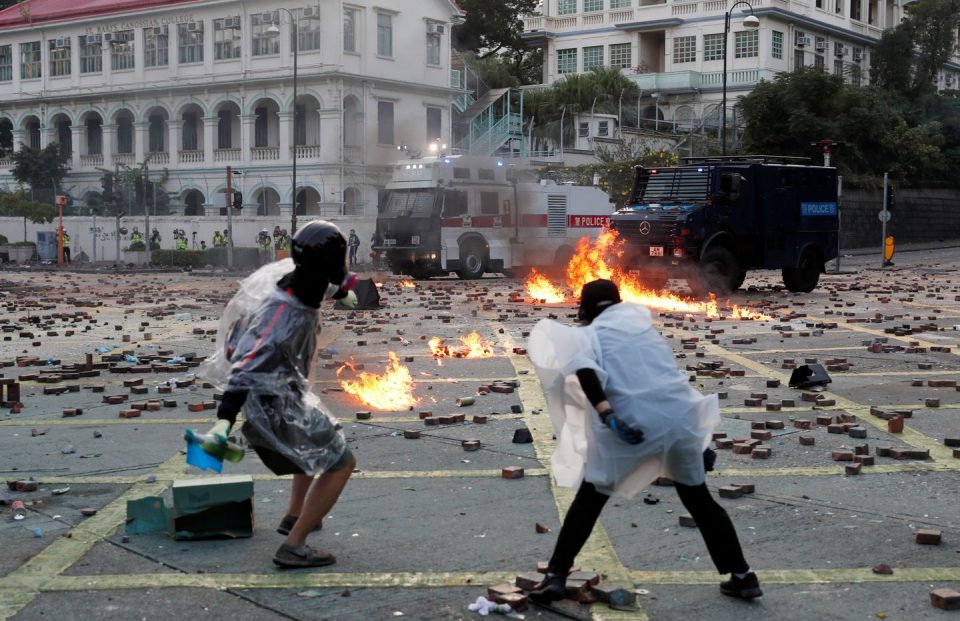The demonstrators, who spent Sunday countering police water cannons of stinging blue dye with gasoline bombs, held their ground early Monday morning local time. Just before daybreak, officers from a special tactical unit entered the campus and made dozens of arrests, according to local news reporters at the site. Then a live feed showed a university entrance engulfed in flames. Demonstrators were feeding the fire to hold off police.
The confrontation showed how many young protesters have followed a steady path of radicalization as the movement presses forward with significant public support. Although police insist on ending the protests and neutralizing their core of front-line activists, it grows increasingly unclear where the unrest will lead, how it will end and whether the damage can be undone
The protesters at Hong Kong Polytechnic University rained molotov cocktails down on riot police officers and their vehicles Sunday in one of the longest days of fighting since the demonstrations began in June. One police media liaison officer was struck in the calf with an arrow. Skirmishes raged into the night, leaving a police vehicle burning and the air thick with tear gas.
As police tried to move in on campus, they warned stronger measures could follow. They sealed the exits, leaving hundreds of students trapped inside the university.
“We will use the minimal force,” police said in a Facebook video. “We are asking the rioters to stop assaulting the police using cars, gas bombs and bows and arrows. Otherwise we will use force, including live rounds.”
In a video widely shared on social media, a protester in a raincoat and a full-face respirator said he would stay at the university “until the end.”
“What will happen to [the students] if we leave?” he asked. “I am so afraid, but I have no choice.”
Police said early Monday that they were trying to disperse and arrest “a large gang of rioters” who “hurled petrol bombs at police” and “set objects ablaze.” In a statement, police said they did not “raid” the campus.
“Fires were observed in various locations in the PolyU premises. Explosives, flammable substances and dangerous goods also pose threats to anyone therein,” police said. “Police appeal to everyone inside the campus to leave immediately.”
In a message released Monday morning, Polytechnic University President Teng Jin-Guang said he had negotiated with police through the night to reach an agreement: Officers would refrain from using force if protesters did not instigate clashes.
“We have now received the assurance of police of a temporary suspension of the use of force under the condition that if the protesters do not initiate the use of force, the police will not initiate the use of force,” Teng said. He added that he would personally accompany protesters who left the campus peacefully to the police station to ensure they were treated fairly.
An open letter by the students inside the campus, posted on messaging app Telegram, accused the university leadership of siding with police to facilitate the arrest of students. They vowed to fight to the end.
“No freedom, no life. We won’t be afraid of arrest or death. Because history will find us innocent,” the letter said.
By early Monday, police had not used live ammunition at the university. Elsewhere, police fired several rounds at protesters who were pelting officers in an ambulance with bricks, but they hit no one, according to witnesses and a video of the incident.
A spokesman for the police force did not immediately confirm the use of live rounds.
A front-line officer, speaking on condition of anonimity, said the police strategy was to surround the campus, block the exits, and wait for the demonstrators to leave. On Monday morning, police made dozens of arrests in the Tsim Sha Tsui neighborhood adjoining the campus, local media reported.
The current pro-democracy movement was sparked by a bill that would have allowed extraditions to mainland China. Hong Kong Chief Executive Carrie Lam eventually scrapped that legislation, but not before the movement had grown to include the long-held demand that the people be allowed to vote for their own leaders and remain autonomous from Beijing. For many here, the events of the past months have eroded their trust in the territory’s institutions — and the police, in particular — while giving rise to a new generation of young protesters who believe this to be the defining fight of their lives.
The all-day standoff began early, with police pummeling front-line protesters with volleys of tear gas and water cannons that streamed irritating blue liquid. Protesters responded with gasoline bombs.
Much of the battle centered on the bridge leading to campus from the nearby metro station, which protesters had filled with barricades. As night fell, they repeatedly set it alight to prevent the police from advancing onto the university grounds.
Via Yahoo


